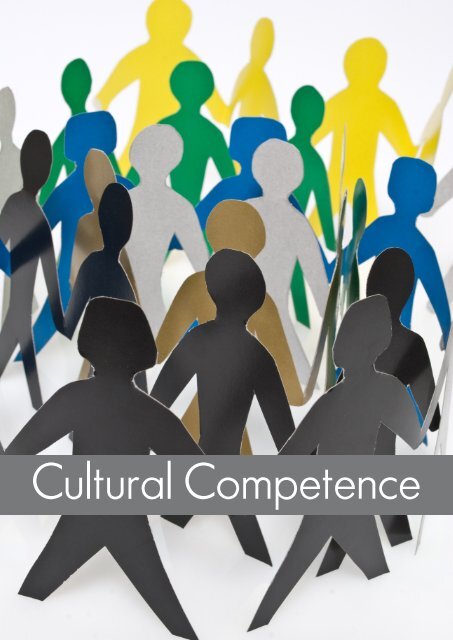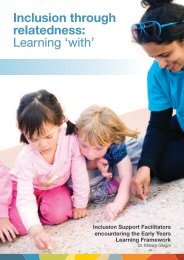Download Cultural Competence - Children's Services Central
Download Cultural Competence - Children's Services Central
Download Cultural Competence - Children's Services Central
Create successful ePaper yourself
Turn your PDF publications into a flip-book with our unique Google optimized e-Paper software.
<strong>Cultural</strong> <strong>Competence</strong>
CULTURAL COMPETENCE / 1<br />
CULTURAL COMPETENCE – SEEING LIFE BEYOND OUR OWN EXISTENCE<br />
<strong>Cultural</strong> competence is identified in the Early Years Learning Framework (EYLF) as one of the pedagogical<br />
practices that informs curriculum decision-making and enhances children’s learning. This fact sheet will explore<br />
the distinctions between culture, valuing cultural diversity and cultural competence, in order to support<br />
educator’s thinking and practices. Reflective questions are included to promote reflection and discussion.<br />
Defining cultural competence<br />
<strong>Cultural</strong> competence is often confused with knowledge of culture or a valuing of cultural diversity. Whilst<br />
these three concepts share some similarities in focus, operationally they are disparate in their aims.<br />
Developing an understanding of culture and the way in which it operates is fundamental to understanding<br />
what it means to be culturally competent. There are many ways to understand culture. Some people may view<br />
culture in broad terms, recognising language, behaviours, attitudes and values as an integral part of culture.<br />
Others may have a narrower and more concrete understanding of culture, focusing on the more tangible<br />
aspects of culture such as food, dress, music and the arts. Sociologists and anthropologists share some similar<br />
views on culture in that they see knowledge of ones’ own culture as necessary for participating in and<br />
understanding society. Seen in this way, culture can be defined as follows:<br />
There are four key elements to understanding the construction of culture. These include:<br />
1.<br />
2.<br />
3.<br />
4.<br />
“the way (people) perceive the world, the way they communicate with one another and, the things they do and<br />
their values. Culture is the system of shared knowledge which people use to govern their own actions and interpret<br />
the actions of others” (Partington & McCudden, 1993, p.12)<br />
Culture is acquired - we learn about culture from others in our community, including our parents<br />
Culture is shared - culture does not exist in a vacuum, it is shared amongst a group of people<br />
Culture defines core values - because we have been taught our culture and share it with our cultural<br />
group, we tend to form the same core values<br />
Cultures resist change but are not static - culture does and can change, but change is usually slow and<br />
gradual.<br />
Kidd argues that “culture is seen as the cement that bonds individuals together. It is made up of shared and<br />
collective symbols and it shapes our lives. It gives us the rules by which to live our lives. It hovers over us,<br />
structuring the world around us”. (2002, p. 10)
<strong>Cultural</strong> diversity in the context of cultural competency<br />
CULTURAL COMPETENCE / 2<br />
An appreciation of cultural diversity is fundamental to cultural competence. <strong>Cultural</strong> diversity is a relational<br />
reality, that is, it is contextual and does not exist as a static quality. All of us are different at some point in<br />
time to the people around us. It is important to remember that at some point in time we are also similar to<br />
the people around us. In being culturally competent individuals must take a philosophical position that cultural<br />
diversity is not problematic. Issues and tensions arise in relation to cultural diversity in circumstances where<br />
little or no accommodation is made for the reality of cultural diversity.<br />
Moll and Greenberg (1990, as cited in Barrera & Corso, 2002, p. 104) suggest that culture is maintained<br />
through the transferral of knowledge from one generation to the next. This process is referred to as “funds<br />
of knowledge”. An example to demonstrate how “funds of knowledge” might operate is as follows:<br />
Knowing how to greet adults who are not family members, for example, requires a specific cultural fund of<br />
knowledge. The content of this fund differs across cultures. In some cultures, children will be taught to remain silent<br />
as a sign of respect. In other cultures, children will be expected to step up and say “hello” and shake hands when<br />
introduced as a sign of respect. (Barrera & Corso, 2002)<br />
It is unrealistic to assume that cultural competence is achieved through the proficiency of funds of knowledge.<br />
No one person can know all there is to know about a particular culture.<br />
The term cultural competence is typically used in reference to the knowledge and skill necessary for facilitating<br />
communication and skills acquisition across cultures (Lynch & Hanson, 1992, as cited in Barrera & Corso,<br />
2002). For others it refers to “the ability … to respond optimally to all children and families (in ways that<br />
acknowledge) …both the richness and the limitation of the socio-cultural context in which children and<br />
families, as well as practitioners …may be operating” (Barrera & Kramer, as cited in Barrera & Corso, 2002,<br />
p. 105).
Using the metaphor of mystery<br />
What comes to mind when you hear the word mystery? For some mystery may provoke the following<br />
thoughts:<br />
• Finding<br />
out more; Looking for clues; Going in search of something that is missing.<br />
Applying the metaphor of mystery is a useful strategy to assist in increasing our ability to be culturally<br />
competent. Freedman and Combs (1996, as cited in Barrera & Corso, 2002) suggest that mystery requires<br />
that we attend to children and families with focused attention, patience and curiosity. In this sense, being<br />
responsive is about being willing to not know for sure, to not know exactly what to do or what to say. All<br />
too often when we approach other cultures with a sense of knowing, we can impede our learning. “Knowing<br />
where we are going encourages us to stop seeing and hearing and allows us to fall asleep…[such knowing<br />
allows] a part of [us] to rush ahead to [our destination] the moment [we] see it” (Remen, 2000, as cited<br />
in Barrera & Corso, 2002, p. 107). Perhaps one of the most effective strategies to increase our cultural<br />
competence is to search for clues, remain curious and retain a desire to find out more about others, whilst<br />
always remaining open to diversity and learning.<br />
Questions for reflection:<br />
•<br />
How have you come to understand cultural<br />
competence? What does it look like on a<br />
daily basis?<br />
• How do you ensure you remain aware of<br />
your own worldview and attitudes towards<br />
diversity and difference?<br />
• How<br />
do you ensure that particular cultural<br />
knowledge and practices are not given<br />
more value or importance than others?<br />
• How do you remain curious in your<br />
relationships with children and families<br />
within and across cultures?<br />
CULTURAL COMPETENCE / 3
References and further reading:<br />
CULTURAL COMPETENCE / 4<br />
Australian Government Department of Education, Employment and Workplace Relations (2009). Belonging,<br />
Being & Becoming: The Early Years Learning Framework for Australia.<br />
http://www.deewr.gov.au/EarlyChildhood/Policy_Agenda/Quality/Pages/EarlyYearsLearningFramework.aspx<br />
Barrera, I. & Corso, R. (2002). <strong>Cultural</strong> Competency as Skilled Dialogue. Topics in Early Childhood Special<br />
Education, p. 103-113.<br />
This fact sheet has been developed by Semann & Slattery on behalf of Children’s <strong>Services</strong> <strong>Central</strong>. Children’s <strong>Services</strong> <strong>Central</strong> is the Professional<br />
Support Coordinator in New South Wales and is an initiative funded by the Australian Government under the Inclusion and Professional Support<br />
Program. Children’s <strong>Services</strong> <strong>Central</strong> is managed by a consortium of key organisations that resource and support the sectors of children’s services<br />
in New South Wales.




